The official recommendation for paint for bathroom walls, especially if you don’t have a good bathroom exhaust fan, is to use a satin or semi-gloss sheen acrylic paint so that the water will bead up on the surface and not soak into the paint and wallboard.
These higher sheens also make it easier to clean and wipe down. Water streaks on bathroom walls do leave marks that need to be cleaned.
You also want a primer that is less permeable is also used to protect the wallboard from water damage. Some painters use oil-based paint because of how moisture-resistant it is (though this is very high in VOCs). There are some water-based options on this list that provide that moisture resistance.
Again, is most important if you don’t have a good bathroom exhaust fan. If you have a good bathroom fan you can use a regular eggshell paint.
Conventional paint formulas, if marketed for the bathroom, also contain added mildewcides to prevent mold, though this is not necessary in a bathroom with good humidity control.
This article contains affiliate links, upon purchase I make a small commission at no extra cost to you.
There are a few ways you could avoid mildewcides while using a flat finish and not have a risk of water infiltrating your walls (and possibly causing mold problems):
- Use a not-very-permeable primer and then use one of the eggshell paints on this list (this can work if your humidity is well under control).
- Use Benjamin Moore Aura Bath and Spa which is a matte finish paint formulated for the bathroom. (I would use this over one of the moisture-resistant primers).
- Use Kerdi Board as your wallboard and then use plaster and paint over that. In this case, your wallboard is not permeable at all so you can use any of the more natural paints over this.
Of course, these recommendations are for a bathroom with a bathtub or shower. (In a powder room you can use any paint you like).
The amount of humidity will also affect your paint choice. If you have a high CFM bathroom fan, or you don’t take hot showers, you won’t need as much moisture resistance in your paint compared to a bathroom with no fan that gets steamy.
Using a eggshell finish has become the norm in bathrooms with a good fan.
What about ceilings? Use the same moisture-resistant paint that you use on the walls on the ceiling as well.
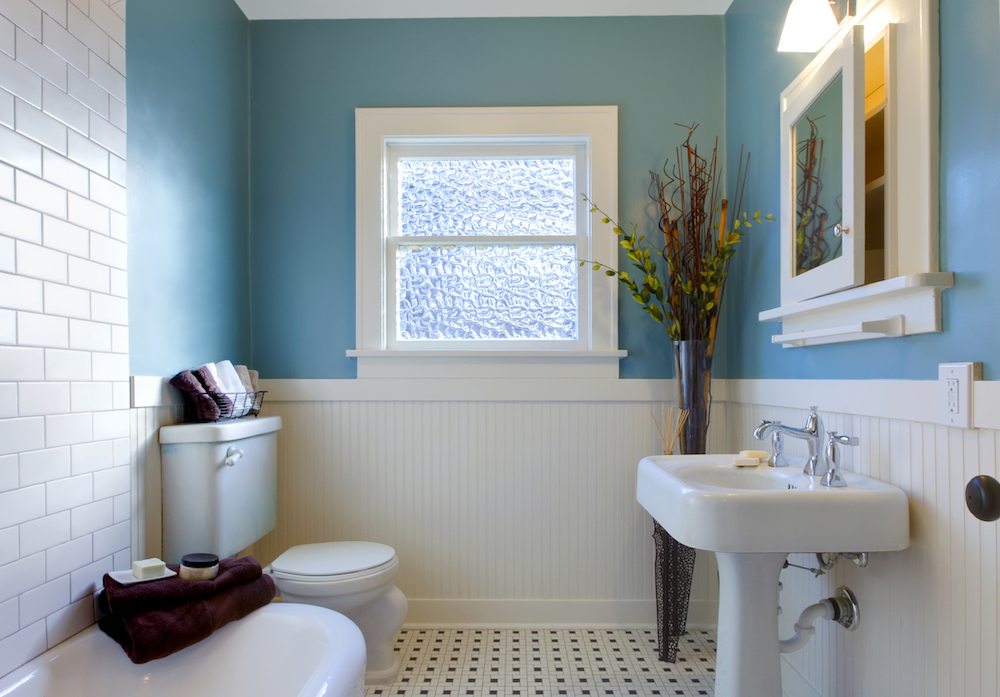
Here are All the Best Bathroom Paint & Primer Options
Vapor Semi-Open (This is What You Want)
1. AFM Transitional Primer and Paint
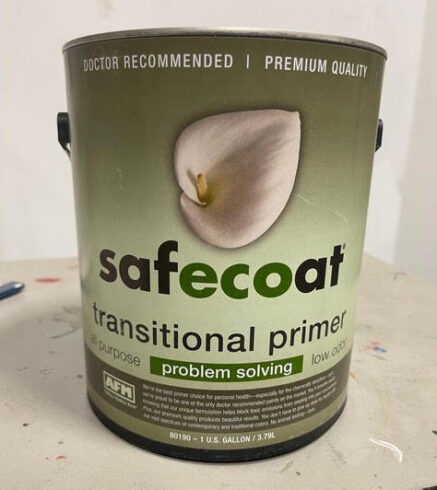
AFM Transitional Primer is the most ideal for a bathroom because it’s not very permeable (while still not behaving as a vapor barrier paint). It has only 9 g/l VOC which is extremely low.
You can paint over this with AFM Safecoat Paint in eggshell, which is higher gloss than their pearl (and higher gloss than eggshell in most other brands), perfect for a bathroom because this causes water to roll off the wall. AFM Safecoat Paint is zero-VOC.
You could also paint over Transitional Primer with any other acrylic paint of your choice.
These formulas don’t have added mildewcide. If you want to stick with one brand for both the primer and paint, this is the most ideal combo for both performance and VOC levels.
2. ECOS Paints (Acrylic paint)
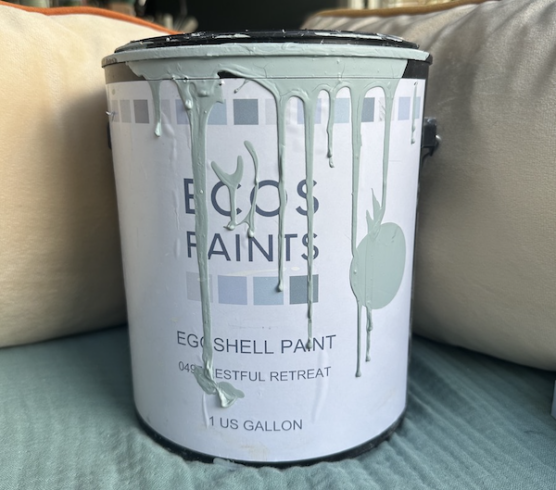
ECOS Paints is a zero-VOC acrylic paint that is one of the favorites amongst the chemically sensitive.
It’s also one of only two paints that provide a Declare Label to show all of their ingredients.
It doesn’t come in satin unfortunately, but you can use semi-gloss or gloss in the bathroom. (Note full gloss usually looks weird on walls).
This does not have added mildewcides but if your humidity is well controlled and there isn’t hidden mold in your bathroom that will be just fine.
All of ECOS paints are 0-VOC (this is quite unique). Use this over AFM Transitional Primer or Kilz below.
3. KILZ Kitchen and Bath Interior Primer

A great water-based primer that provides moisture resistance and less moisture infiltration into the drywall is Kilz Kitchen and Bath Interior Primer. The VOCs are only 5 g/l.
This would be a good primer to use with ECOS Paints.
4. Caliwel (high lime content acrylic paint)
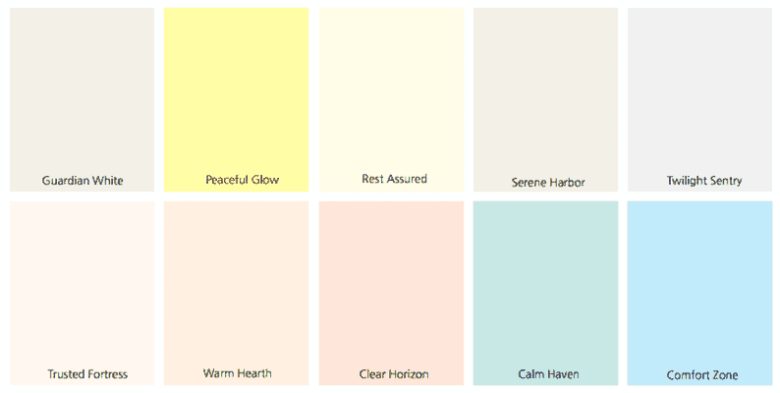
Caliwel is naturally antimicrobial and mold-resistant by way of the high lime content in the paint.
This paint only comes in one sheen which they describe as “flat going on eggshell” which is not the most ideal for a bathroom unless you are painting over a durable (not very permeable) primer like AFM Transitional and have well-controlled humidity.
It comes in 10 colors.
5. Benjamin Moore

Ben is zero-VOC and Aura is a high-quality sub-line that’s so close to zero-VOC that the difference is not significant.
Both come in satin, which is ideal for the bathroom.
If you want a paint with added mildewcide and a matte finish, Aura Bath and Spa is one of the only zero-VOC bathroom formulas. This paint has been specifically formulated to withstand the common issues found in high moisture areas, such as water-streaking (water marks left on the paint surface) and surfactant leaching.
Though it is still a breathable paint and water won’t bead up on it, says David Underwood, Associate Technical Project Manager at Benjamin Moore.
Benjamin Moore’s Kitchen & Bath paint is another of their antimicrobial paints but this one has a satin finish, it is low-VOC at 37g/l.
In terms of Ben Moore primers, they recommend Fresh Start High-Hiding All Purpose Primer for new drywall. It is low-VOC at 48 g/l.
Or you can use INSL-X Aqua Lock which is 45 g/l. The company says these provide more moisture resistance (and are less permeable) than your most basic primer.
6. BEHR
For a primer, they recommend BEHR Kitchen, Bath, and Trim Stain-Blocking Primer and Sealer (VOC under 5 g/l).
This is not a “vapor barrier” primer (all their products have a perm rating over 1.0) but it does have the highest moisture resistance with added mildewcide for a bathroom.
For paint, they recommend BEHR Ultra Scuff Defense Stain-Blocking Paint and Primer in One if you want a flat finish that is durable and washable with the scuff resistance of gloss paint – but it will absorb moisture (no added mildewcide, it’s low-VOC at 19 g/l).
For bathrooms, it’s ideal to have a satin finish so that water doesn’t soak in very much. The Ultra Scuff in satin (19 g/l VOC) or Dynasty in satin (21 g/l VOC) is fast drying and stain-repellent. Both will work for a bathroom though there are lower VOC paint options in other brands.
Buy at Home Depot.
Vapor Open Paints
Next are vapor-open paints that may be marketed for the bathroom but are only acceptable if your wall type is designed to absorb the moisture from the air safely or your walls are not permeable at all.
Warning: I would not use a vapor-open (“breathable”) paint with any gypsum-based wallboard, including regular drywall or MMR (“green board”) except in a powder room.
1. Graphenstone (high lime content biobased paint)
A paint that relies on a high lime content to provide natural antimicrobial resistance. The company claims it’s made with a biobased binder and not acrylic, though they don’t make it clear what kind of biobased binder it is or provide any evidence that it is biobased. It does smell like an acrylic paint, but unlike acrylic, this paint is “breathable” so moisture will go through to the wall. It’s also washable.
2. Auro Anti-Mould Paint (high lime content biobased paint)
Another biobased paint that is high in lime. This makes it naturally anti-microbial. This brand has certifications showing that it is bio-based. It’s a matte finish that is breathable.
3. Kiem (silicate/mineral paint)
Kiem Interior Mineral Wall Paint (called Innostar in Europe) is made primarily with silicate binders which do not offgas or have an odor, and just a very small amount of acrylic binder. This paint is almost odorless when wet which makes it unique.
Kiem is listed as zero-VOC and it’s for use on new or previously painted drywall or plaster. It’s self-priming on both bare and previously painted surfaces.
Kiem has a perm rating of 77 so it’s highly vapor open. Silicate paint is great if you want an odorless paint that has a very flat finish and is also washable.
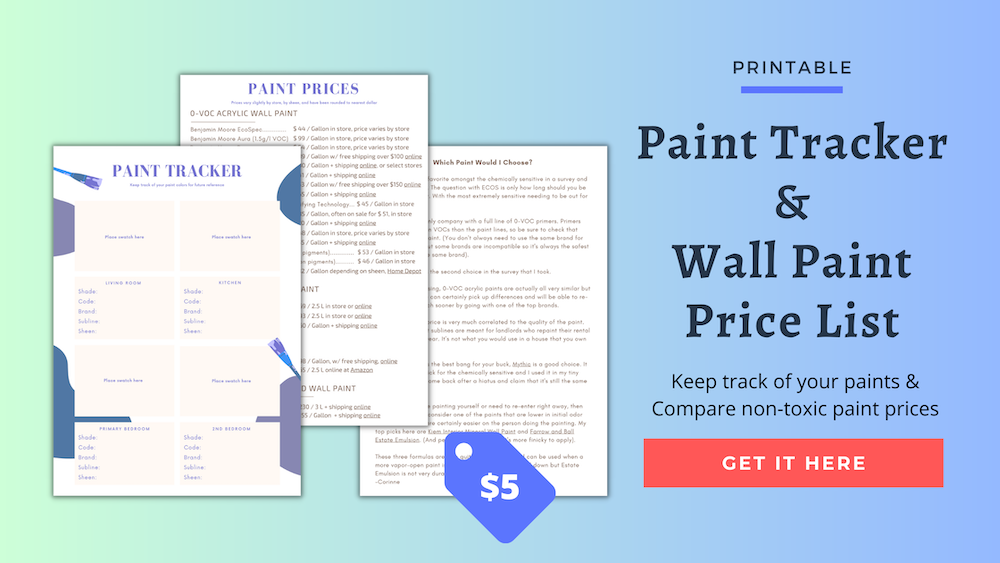
Corinne Segura holds certificates in Building Biology, Healthier Materials and Sustainable Buildings, and more. She has 10 years of experience helping others create healthy homes.
If you would like to support the research behind this blog you can make a donation via Kofi!
Sources:
Conversations with reps from Benjamin Moore, BEHR, ECOS, Mythic, Auro, Graphenstone and Kiem
Conversation with Cheryl Ciecko, architect

CM
Thank you for this, it is so helpful! I was wondering if there is any Sherwin Williams paint (and primer) your recommend for bathrooms?
Corinne Segura, Building Biologist
in the sherwin williams article, duration
Elizabeth Clark
Hi there! Thank you so much for your hard work and dedication, your website is my go to resource for picking safer building materials and paints. We need to find a primer and paint for our bathroom and I was looking at the AFM Transitional Primer, but noticed this in the description:
“NOTE: This primer should not be used over wood with tannins that will bleed through such as cedar, pine, or other oily woods”
Part of our bathroom is pine shiplap on the walls, so I need a primer that can go on raw wood (specifically pine). Thanks for your time and help, I really appreciate it!
Corinne
shellac/shellac based primer or Zinsser 123. test for tolerability if sensitive.
Bryan
The safecoat pain sheens have opposite naming from other brands. Pearl is lower gloss than their eggshell.
Corinne
ah thanks for that catch I didn’t know that.